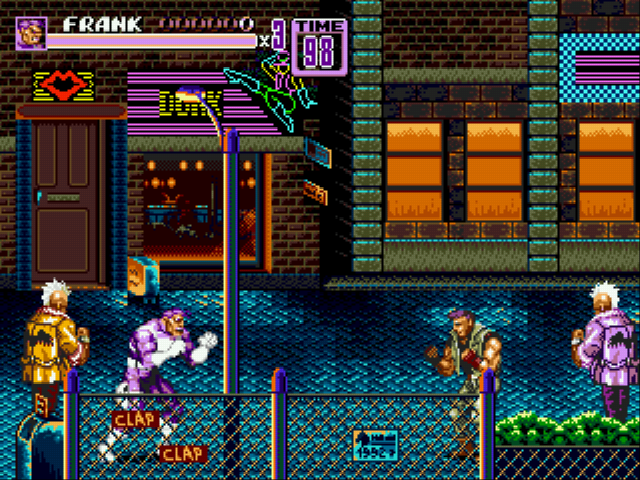Streets Of Rage Online

Streets of Rage 3, known in Japan as Bare Knuckle III (ベア・ナックルIII Bea Nakkuru Surī), is a side-scrolling beat ’em up developed and published by Sega in 1994 for the Sega Genesis. It is the third and to-date, final installment of the Streets of Rage series. It was later released for the Japanese version of Sonic Gems Collection for the Nintendo GameCube and PlayStation 2, and for the Wii Virtual Console in September 2007. The game also appeared in Sonic’s Ultimate Genesis Collection for Xbox 360 and PlayStation 3.The game features several enhancements over Streets of Rage and Streets of Rage 2 such as a more complex plot, multiple endings, longer levels, increased difficulty, more in-depth scenarios and faster gameplay. Weapons could now only be used for a few times before breaking and could be integrated with unique moves with certain characters, hidden characters were added and a few cutscenes were included to give the story greater depth.The game is faster-paced than its predecessors. Running and vertical-dodge moves were added (only Skate could run in Streets of Rage 2), and most player attacks deal less damage than in the predecessors. The level timer has been replaced with a “power meter” that, when full, allows players to perform special moves without draining the player’s life bar.Unlike the first and second game, weapons in Streets of Rage 3 can only be used a fixed number of times.
However, additional weapon special attacks could be performed. The game also features return of Streets of Rage team attacks in which two characters work together to perform a powerful attack as in the first game. Blitz moves, performed while players run, were altered so that they can be upgraded in strength over the course of the game. The player would have to earn a set amount of points on one life to upgrade it. Losing a life would put the blitz move down a level, but the upgraded moves could still be performed by pressing X on a 6 button controller, followed by a button sequence.Traps in stages were brought back from the original game. For example, enemies can once again be thrown into pits or off the side of an elevator. Enemy AI was expanded so more enemies can pick up weapons, block attacks, employ co-operative attacks (usually, a Big Ben-like enemy will throw one of the Garcia enemies at the character to smack them down), and even steal exposed food items to regain health.Post navigation.
If you’re looking for news or information on Streets of Rage, you have come to the right place! This site has been created to produce relevant fresh content on Streets of Rage, from latest updates to essential podcasts, this site has all the information you need, enjoy your time at SOR Online! Streets of Rage Remake Community Forums SorR Community Forums.
Streets of Rage[a] is a series of side-scrolling beat ’em up video games, centering on the efforts of several heroes trying to rid a city from the rule of a crime syndicate. The original trilogy of games were developed and published by Sega for the Sega Genesis in the 1990s, and have since been ported and re-released on various platforms. A fourth entry in the series is being developed by DotEmu, Lizardcube, and Guard Crush Games.
The games were well-received and have been re-released many times both on compilations and as standalone titles. The electronic dance music soundtracks of the games, scored by Yuzo Koshiro and Motohiro Kawashima, have also received much acclaim.
The three games in the series were released between 1991 and 1994. The first entry, Streets of Rage, introduces the main characters: three young former police officers (Axel, Blaze, and Adam), and Mr. X, an evil mastermind. It is the only game in the series to feature a special attack that defeats all non-boss enemies on-screen. Streets of Rage was supported by Sega’s Mega Drive (known as Genesis in North America), Master System and Game Gear consoles. Color tunnel unblocked 76.
The next entry in the series, Streets of Rage II, had new music (influenced by early ’90s club music) from series composer Yuzo Koshiro and newcomer composer Motohiro Kawashima, more defined graphics and a bigger selection of moves. It also introduced two new characters, Eddie “Skate” Hunter, and Max Thunder (or Sammy “Skate” Hunter and Max Hatchett in some regions). Like the original title, Streets of Rage II was playable on Sega’s Genesis, Master System and Game Gear.
The final entry to the Streets of Rage series, Streets of Rage 3 was less well-received than its predecessors. Despite some enhancements, it has been seen as very similar to Streets of Rage II. This entry to the series added a more complex storyline, told using cutscenes. The Western version released featured increased difficulty, with other elements altered or censored from the Japanese release. The music, again composed by Koshiro and Kawashima, was also criticized for being radically different to the music from the first two games. Unlike the two foregoing titles, Streets of Rage 3 was available only on the Genesis.
All three titles have been re-released on numerous platforms and compilations, including Sonic Gems Collection[1] and Sonic’s Ultimate Genesis Collection, and on the Wii’s Virtual Console, Xbox Live Arcade.